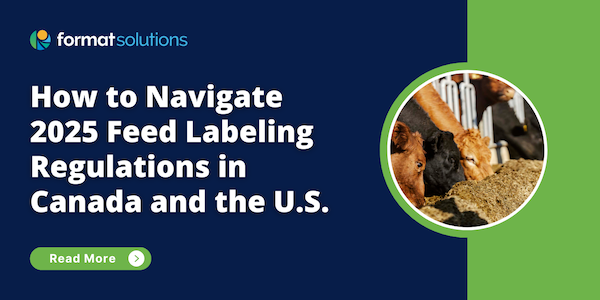How to Navigate Feed Labeling Regulations

Labelling animal feed can be a complicated business due to regulations in the US & Canada.For each market served, not only does the feed label have to show accurately what’s in the container, but it also must also provide feeding and dosage information as well as any health and safety warnings.
Starting in June 2025, new Canadian regulations will further complicate matters by requiring all animal feed products sold there to be labeled in both English and French.
Format Solutions’ FeedTags and SLabel add-ons aim to make the process of labeling simpler, ensuring these regional requirements are met and that formulators remain compliant.
“There are many labeling requirements across the U.S. with different states requiring different levels of detail,” says Laura Harthan, Product Specialist at Format Solutions. “There’s also quite a lot of difference between Canadian and U.S. labeling regulations. In Canada, not only is there a different set of rules, but labels will have to be in English and French from June this year.”
Meeting the Latest Requirements
Format Solution’s FeedTags and SLabel tools help users generate labels that comply with the latest regulations, making it easier to demonstrate to their customers that the feed they’ve bought contains all the ingredients that their livestock need.
Feed makers can face all kinds of difficulties trying to get their labeling right thanks to a complex patchwork of regulations across different regions or states.
California, for example, requires feed makers to list every ingredient in feed formulations. Other U.S. states, however, are happy with using collective terms such as plant-based protein or grain products for the commodities in the formulation, says Harthan.
At a Glance
-
There is a complex patchwork of state regulations that feed makers must comply with.
-
A dual language requirement in Canada will be implemented in June 2025.
-
Feed labels must accurately reflect the contents of feed.
-
Both label and feed must comply with local regulations.
It has taken Format Solutions’ many years of experience and sustained investment in this marketplace to develop the FeedTags and SLabel systems.
In response to customer feedback, we’re looking at how to introduce labeling that incorporates QR codes, so more information can be included compared with the current barcoded labels.
These barcodes can seamlessly integrate with Feed Mill formulation and production software, which enables the labels to be booked for printing when the formulation is scheduled to run in the plant. As the process runs all the way from initial formulation to label, the label guarantees the product formulation.
The software can also be used as a standalone product that integrates with Format Solutions’ Feed ERP software.
Harthan notes that the software will flag if the formulation contains medication and if it is within tolerance for the purpose it is being sold for. This helps formulators avoid putting too much of an expensive ingredient into the feed, or underdosing.
Constant Monitoring
Additionally, if the formulation changes, the software will check whether it is within scope either of the specification or the actual amounts of the ingredients used in each batch of feed.
“Typically, a label will contain the name of the feed, what the feed is for, the form the feed is in. The ingredients and a lot number – to allow traceability back to the production batch – will be on there for traceability,” says Harthan. “Importantly, the label will contain any warnings which the marketing location requires. Recommended uses for the feed and expiration date round out the kind of information provided.”
Although the incoming Canadian regulations are new, the ability to write labels in French has been part of the Feed Tags program for over a decade.
“Turning on the French language settings in FeedTags and SLabel is something our customers can do on their own, but we’re here to support them if they need help,” continues Harthan. “The changes can be made within the software and Format Solutions has sent ‘how to’ documentation to clients already.”
Staying Compliant
There are two ways to comply with the Canadian regulations. Either the labels can be printed with French on one side of a document and English on the other. Alternatively, they can be printed as two columns on the same side of a document – with French displayed on the left.
“You can print labels on any material that will handle a PDF or .doc file,” she says. “It’s a really flexible solution; some people like stickers, others card-stock tags, and others print the labeling directly onto the side of the feed bag. If you’re delivering a bulk load of feed by tanker, for example, then the label will be included with the paperwork.”
The new Canadian labeling regulations may appear daunting to feed mill owners but rest assured that Format Solutions has been handling complexities like these for its customers for many years and is always on hand to help, says Harthan.
Format Solutions has established itself as a leading software provider supplying animal feed manufacturers across 93 different countries. The FeedTags and SLabel systems are among our latest innovations to assist the feed industry. To find out more, or to request a demo, get in touch.

